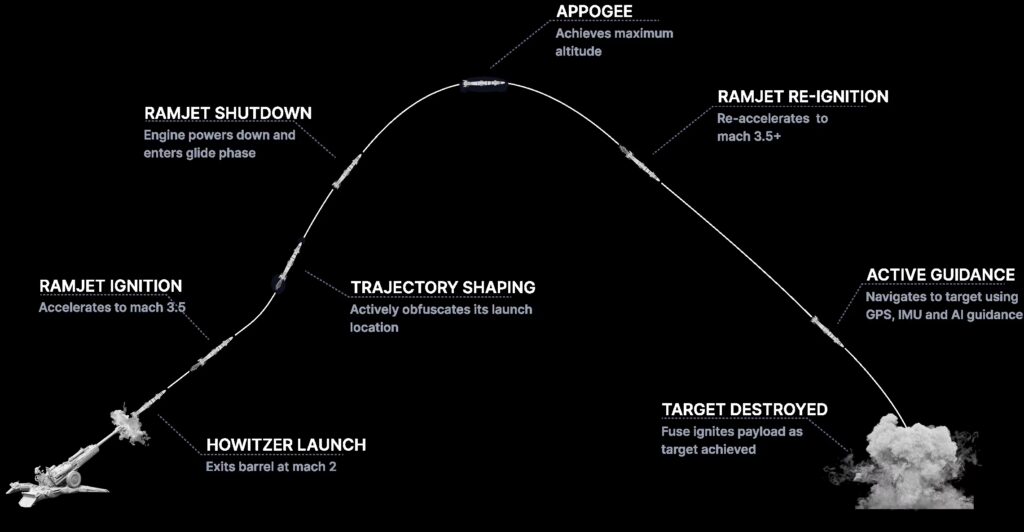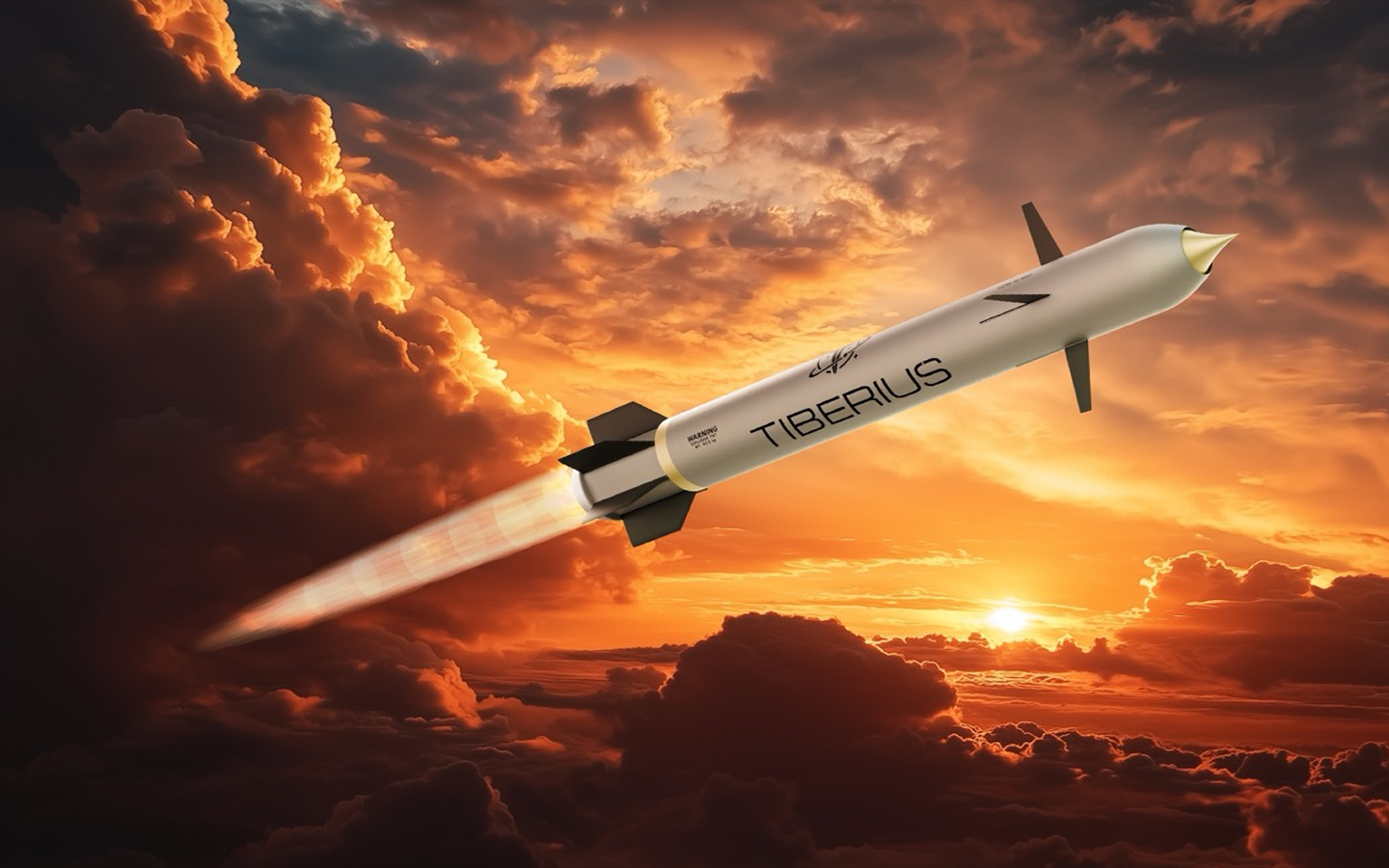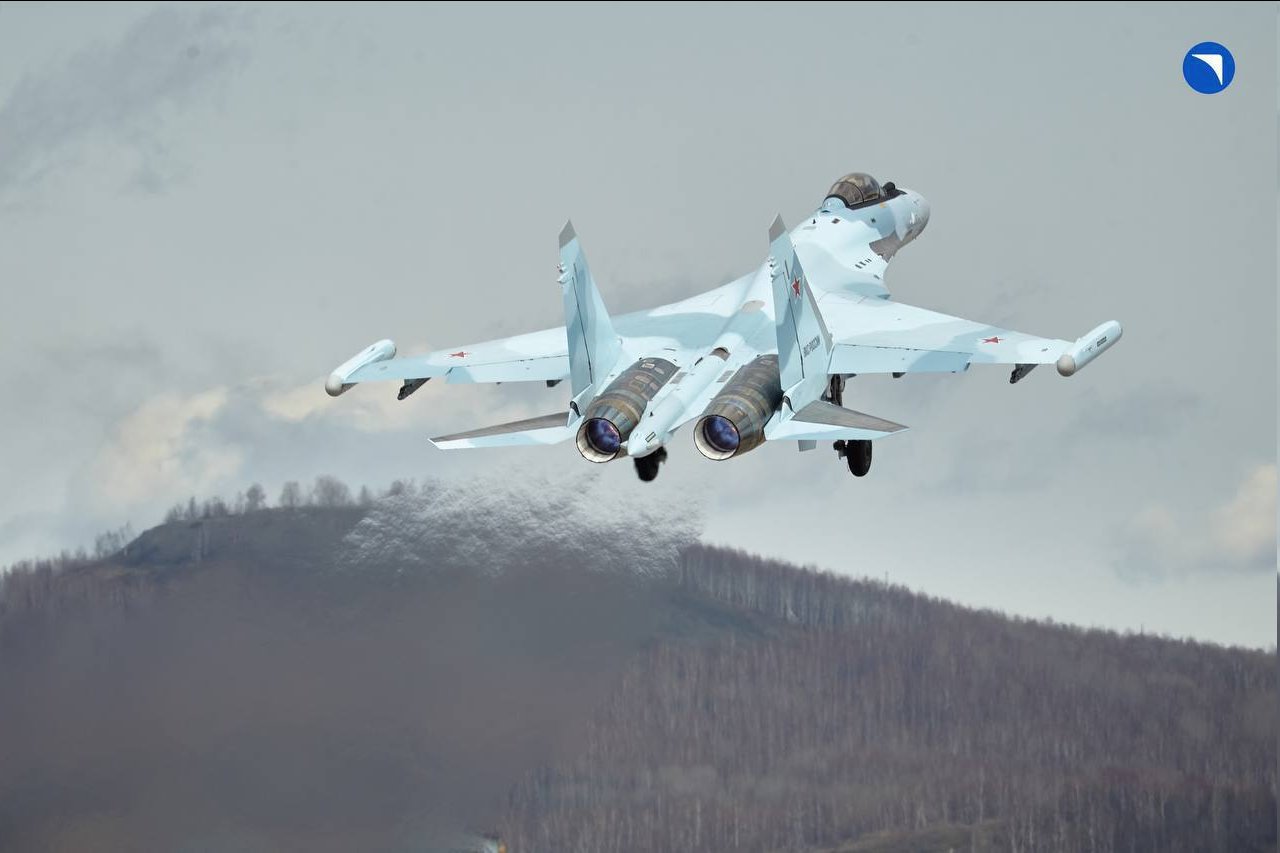Tiberius Aerospace unveils Sceptre; a 150 km 155 mm round
Tiberius Aerospace has emerged from stealth to launch Sceptre, a ramjet powered 155 mm artillery round designed to provide accurate strikes out to a range of 150 km, in an exclusive release to Calibre Defence.
Sceptre is the company’s first product and serves as Tiberius’s exit from stealth. This is a term often used by startups and tech companies, it means that the company has operated without a public profile for its existence to date. This helps companies to develop their intellectual property, complete product development and potentially secure a first mover advantage.
Funding for Sceptre’s development has been “through a partnership of private and public capital. The weight of this funding is private – public capital has been essential for unlocking system qualification,” Andy Baynes, the Chief Strategy Officer at Tiberius told Calibre Defence. They are aiming for production deployment by the end of the year.
The system qualification has included test-firings in the US, which are set to continue in the weeks ahead, Andy added, emphasising that the company uses “a design-test cycle that accelerates development and validation to achieve speeds more akin to Silicon Valley software models.” The test firing has been done using an M777 in the US, and the company is working on qualifying Sceptre for other weapon systems with automatic loaders.
The company adopts what is often known as a continuous integration/continuous deployment approach, with products continuously iterated throughout their lifecycle. This is an increasingly common phenomenon within the defence industry, with companies like Anduril and Helsing working to deploy what are likely early capabilities, with the intent that operation and testing will rapidly bring the product up to a much higher standard. Tiberius can adjust and revise products and get the revised product to testing within three weeks.
The cost balance of war
Another core driver of current developments is cost. Western systems are often very expensive. From the F-35 through to even small arms and ammunition, western governments are generally paying more for their platforms and ammunition, which reduces the quantity that they can procure. Conscious of this, Sceptre has been designed to be cost-efficient for munitions in its class.

Sceptre is designed to be fired from conventional tube artillery. This graphic shows the different components of the round. The payload can be modified to suit user requirements. Credit: Tiberius Aerospace
“On a unit basis, Sceptre is less than 10% of the cost of a GMLRS. This cost-factor tilts further in favour of Sceptre when the logistical footprints are compared. Sceptre has been designed to achieve range, precision and mass,” Andy said. The all up round costs $52,000 (£39,156/€46,592) without the payload and fuel, and that volume production could reduce this to $42,000 (£31,626/€37,632), Andy said in a 19th May briefing. Tiberius believes that ammunition should be considered in terms of a Cost-Effective Lethality Score; how much does it cost to defeat the target. To that end, the company is also open to other companies manufacturing the round at a 25% fee if they can produce it at a lower cost. It is built using readily available tools like additive manufacturing and standard CNC machine tools, providing a separate supply chain and manufacturing capabilities from standard 155 mm ammunition. Tiberius would not be the manufacturer of the round, and has worked with over 20 vendors to produce the initial rounds for test firing.
MoD’s can gain access to Sceptre by paying a $5 million fee and then paying $2.5 million per year thereafter, which allows them to manufacture the munition, Chad Steelberg, the company’s co-founder said. This enables the company to keep its best engineers engaged in modifying and improving Sceptre with new product cycles that are closer to those of phone companies like Apple, rather than traditional defence product development, he added.
ER GMLRS – the Extended Range Guided Multiple Launch Rocket System round – is an interesting comparison because it is also capable of precise strikes at ranges up to 150 km. It can be fired from the M270 MLRS and M142 HIMARs rocket launchers and realistically represents the furthest reach of a brigade-level artillery capability. Longer-range weapons, like PrSM or CTM-290 fired by the Chunmoo, would likely be held at a higher level of command. As a howitzer fired system, Sceptre could potentially provide commanders with a greater variety of options to engage targets that are located beyond the immediate frontline.
Tiberius Aerospace is a US company, which means that “in the short-term Sceptre will be US manufactured, however the Tiberius model is designed to enable the build-out of each sovereign-nation’s domestic manufacturing base,” Andy said. “This democratises manufacturing and encourages a competitive landscape that benefits the user,” he added, touching on an issue that is core to many western nations. “Everyone wants domestic production” an industry source told Calibre Defence in late 2024, and many recent announcements demonstrate this. So, Tiberius’s approach of starting with production close to home before expanding in line with export success is sensible.
Sceptre is not the only long-range precision strike capability on the market, General Atomics is also developing the Long-Range Manoeuvring Projectile (LRMP). LRMP offers a range of 120 km from conventional 155 guns and glides to its target. “LRMP and Sceptre start from the same point – they both seek to extend the range of the 155 mm howitzer whilst enhancing precision. Sceptre uses ramjet technology to exceed the performance of LRMP whilst reducing the cost to almost half of Excalibur. For the warfighter, this unlocks the ability for precision surgical strikes or the massing of fires,” Andy emphasised.
For reference, the cost of an Excalibur is often estimated at $100,000 (approx. £79,365/€92,593), while a single GMLRS round is estimated to cost $168,000 (£133,333/€155,556) and an ER GMLRS up to $500,000 (£396,825/€462,963) for export customers. The big difference between Sceptre and GMLRS rounds is the warhead, Sceptre’s maximum payload is 5.2 kg, but an M31 GMLRS round will have a 90 kg warhead. This can be an excessive payload for some targets, and the company’s approach is designed to optimise weapon to target matching whilst retaining accuracy at range, Andy said in reference to the differences in payload.
Tech profile: Sceptre

This graphic shows the various launch phases of the Sceptre 155 mm guided round. High quality and persistent ISTAR at 150 km is an essential requirement for deep fires. Credit: Tiberius Aerospace.
Sceptre is a 155mm ramjet extended-range precision-guided ballistic munition designed to be fired from standard large calibre artillery systems. Sceptre is fired using a standard propelling charge, which gives the round its initial propulsion and speed enabling the ramjet to ignite. It reaches speeds of Mach 3.5 within six seconds of launch and altitudes in excess of 65,000 feet (beyond jamming range). The ramjet is liquid-fuelled using seven litres of diesel, JP-4 or JP-8 and a just in time delivery methodology where the round would be fueled in the field; this process takes a few seconds, Andy said. This propulsion method also provides a shelf-life of up to 20 years, which can be double that of a solid-fuelled rocket motor typically found in missiles.
Sceptre has an extended range up to 150 km depending on payload, which can be a maximum of 5.2kg using conventional TNT and the space can be provided with fragmentation sleeves. The round also includes a tungsten core to increase its penetrating effects, and the company sees it as a round designed for hardened high value targets. The round has a circular error probability (CEP) of 3.5 m to 5 m, even in GPS contested battle spaces. The all up weight of the round is 47.5 kg and it is 1.55 metres long.
Its ignition system and limited barrel contact points minimises barrel degradation, and the round can use standard, existing 155 mm round fuzes. It is built with a modular, open architecture that allows for future software and hardware upgrades, which could include a seeker to enable the munition to engage moving targets if this was a customer requirement, Andy continued to explain.
The guidance system has a simple user interface for target selection and supports an open API for 3rd party fire control platform integration. During flight, the onboard GPS and inertial measurement unit synchronise and leverage advanced AI to error correct to desired confidence levels, allowing operation in degraded or GPS denied environments, according to the specifications released by Tiberius. If needed, multiple munitions can communicate in-flight to further refine the targeting solution, an approach which is growing in popularity for GNSS-denied navigation.
Company profile: Tiberius Aerospace
Tiberius Aerospace was founded in 2022 to bring a new approach to defence technology that is more closely aligned to practices in Silicon Valley. This typically means rapid development with early product deployment followed by further debugging and plug-in upgrades. It is developing a defence-as-a-Service model, which decouples innovation from manufacturing, enabling rapid iteration, sovereign collaboration and continuous evolution of capability for the UK, the US and their closest allies, the company states. It currently employs 20 people, many of whom are engineers and spends around 90% of its budget on innovation, Chad said during a briefing to journalists on the 19th May.
The company was co-founded by Chad Steelberg, a serial entrepreneur who co-founded Veritone, an American artificial intelligence (AI) technology company that provides a range of AI software, applications, and services to commercial and government organizations. Chad also founded several advertising companies in the early 1990s, and established Tiberius Aerospace to meet what he saw as the challenges of modern warfare. Together with his co-founder, which he believes requires a new approach to innovation and production. Andy Baynes is the chief strategy officer at Tiberius and Chad’s co-founder. Andy has held executive roles at Nest, Google, and Apple, and co-founded a company called GT in 2019, which is a software engineering, data science, and product design company employing 200 tech specialists from Ukraine, Poland, Romania and Turkey.
Calibre comment
Combat is often defined to a large extent by the reach of the weapon systems that are used. Airpower has typically provided the greatest reach, potentially allowing a force to range far and wide throughout its adversary’s depth. However, this has led to the development of advanced air defence capabilities, which can be seen around the world. Russia, in particular, is able to cue long-range air defence interceptors using passive radar, which means the targeted jet would have little to no warning of an incoming attack. But Russia is not alone, China’s air defence capabilities are likely to overtake Russia’s, they are often regarded to have better seeker technology and rapidly advancing radar capabilities. Consider also, Pakistan’s recent engagement with India, in which an Indian fixed wing aircraft appears to have been brought down with a PL-15 air-to-air missile, or the Houthis’ success in downing US MQ-9s and Saudi aircraft. In short, air defence is widespread, and now capable enough to hold even advanced aircraft at risk.
So, this means that most countries are looking to ground-launched effects to extend their reach, combined with massed intelligence, surveillance, targeting and reconnaissance (ISTAR) assets. In Ukraine, the close pairing between ISTAR and strike assets, including artillery and GMLRS, means that there is effectively a 60 km zone in which large groupings of vehicles and troops are very likely to be quickly engaged and destroyed. In this type of scenario, having an artillery capability that can extend the engagement range allows guns to be deployed out of reach of many of the counter-battery threats that dominate the modern battlespace like the Lancet loitering munition. Alternatively, they also enable a force to reach deeper into an adversary’s operational depth, striking at ammunition depots and command nodes. However, it is worthwhile re-emphasising – as is the case with all attempts to establish deep-strike capabilities – that the effects can only ever be as good as the ISTAR assets assigned to them. A precision strike requires precision find, so it is imperative that armed forces ensure they can properly resource their reconnaissance pipeline for assets like Sceptre, making mass procurement of drones a symbiotic asset for long-range artillery.
By Sam Cranny-Evans, published on 19th May, 2025. This article was updated with additional information on the 19th May, 2025.

Sign Up for Updates!
Get insider news, tips, and updates. No spam, just the good stuff!







